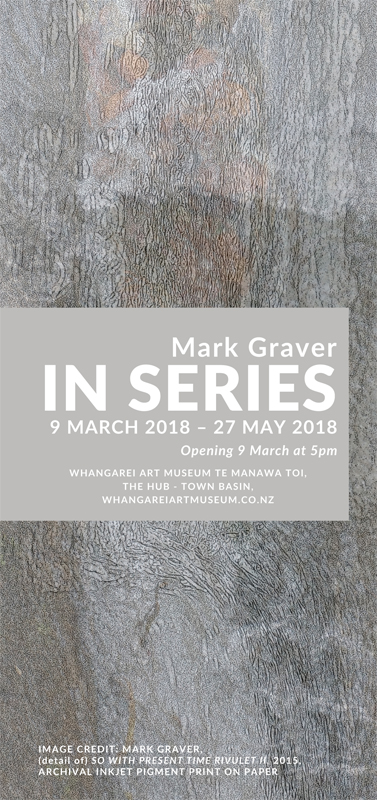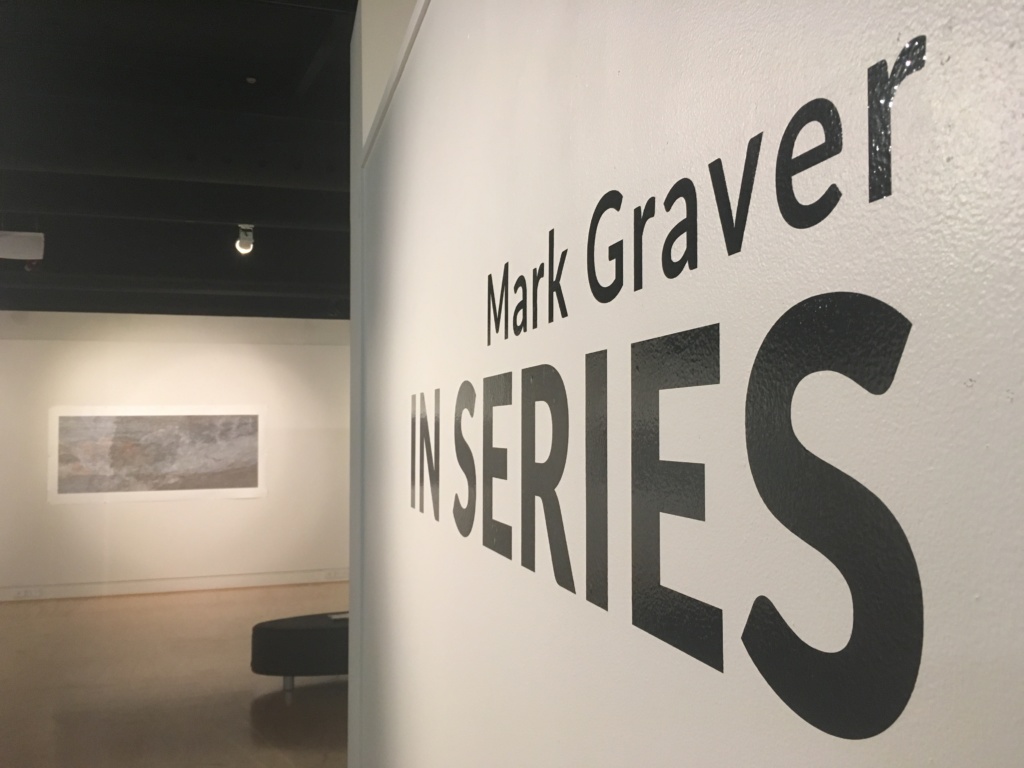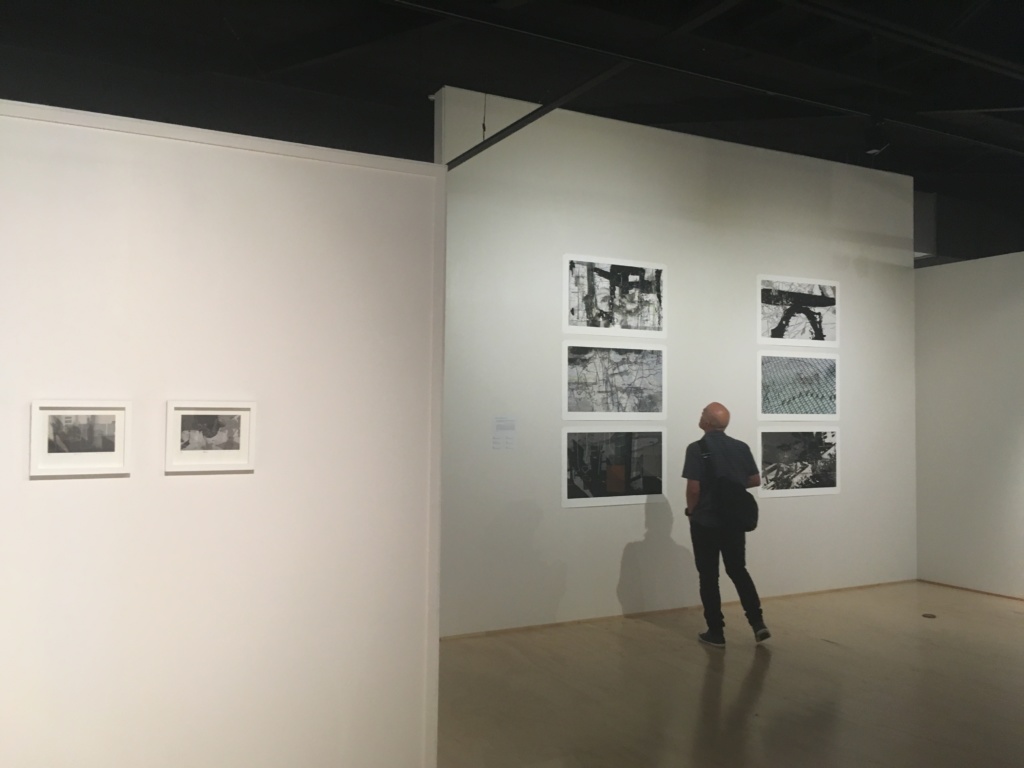In Series, an exhibition by Mark Graver at the Whanagrei Art Museum.

Working ‘In Series’ allows for a wider and deeper exploration, evolution and development of linked ideas.
Printmaking lends itself to series-based work. There is a long tradition of editioning and working in suites, collected folios or narrative sets (Hogarth’s Rake’s Progress, Picasso’s Vollard Suite, Goya’s Disasters of War, Hokusai’s Views of Mt Fuji etc.)
The works presented here correspond technically, conceptually and through content, often with related images being manipulated and developed from a single source to form bodies of work with multiple, non-hierarchical entry and exit points.
Working with on-going, fluid series allows me to by-pass the question ‘what shall I draw?’ as there is always a framework and structure of ideas on which to draw.
The series are on-going and fluid but can also exist individually as stand-alone works or as grouped installations.
The series themselves are also connected through the overarching theme of memory, place and time.
In Series – The Exhibition

THE LAST OF WHAT HAS PASSED
SO WITH PRESENT TIME
A series focusing on stilling the motion of water to reflect on the passing of time in relation to a quote by Leonardo da Vinci, “In rivers, the water that you touch is the last of what has passed and the first of that which comes; so with present time”
These works were made while undertaking an international artist residency at the University of Tasmania in Hobart, Australia in September 2016. The works made during the residency were inspired by the Hobart Rivulet and its place in the history of the town and have links and connections to other on-going series that use imagery sourced at home and abroad – the Kerikeri River and the River Ver in my home town of St. Albans, England. This is the first time the works have been shown in NZ.
IMAGINED AND REMEMBERED PLACES
‘Real images are engravings, for it is the imagination that engraves them on our memories. They deepen the recollections we have experienced, which they replace, thus becoming imagined recollection’
Gaston Bachelard, – ‘The Poetics of Space ‘first published 1958, trans. Maria Jolas, Boston, Beacon Press 1969 p. 32
A series of ‘landscapes’ based around images of places and spaces visited, recorded, imagined and remembered. The works began by re-visiting photographs and sketches made at a particular time in a particular place.

They are layered, much in the way memories are, and manipulated – things come to the fore, emerge then disappear. Technically there is a relationship to working with moving image and layered video and some images could be regarded as ‘film stills’. The addition of scanned sketches and digital drawing intends to reference the time and place as recorded on paper and remembered on screen.
STILL MEMORABLE STILL
When my father died we planted two trees. One, a Salix Caprea (pussy willow) outside my family home in The Poplars in St. Albans, England and one, a Yen Ben lemon outside our house in Kerikeri, New Zealand.
We scattered his ashes under a laurel bush in Garston cemetery where oak trees grew nearby.
UMBRA SUMUS
Taken from a quote by Horace, ‘Pulvis et umbra sumus’ (we are but dust and shadow) Umbra Sumus is an ongoing project containing photopolymer and acrylic resist etchings, digital prints and video works.
The series began partly as a response to the death, in January 2011, of my father, and has evolved to become more a reflection on personal history and the wider human condition.
The use of shadow alludes to the movement of light, the passing of time and, ultimately, to mortality.
The shadow source photographs are gathered from different places and countries to emphasise the universal correspondence of shared existence.
FLANEUR SERIES
‘Photography first comes into its own as an extension of the eye of the middle-class flâneur, whose sensibility was so accurately charted by Baudelaire. The photographer is an armed version of the solitary walker reconnoitring, stalking, cruising the urban inferno, the voyeuristic stroller who discovers the city as a landscape of voluptuous extremes’
Sontag, Susan, 1933-2004. (1977). On photography. New York: Farrar, Straus and Giroux,
INTRODUCED BIRDS
I remember walking down the road in Kerikeri one day and seeing a flash of orange from a blackbird’s beak. I remember as a child having to come in from playtime and go to bed when it was still light outside and listening to the blackbird’s song. A memory of place. The nostalgia of sound.
As an immigrant to New Zealand I can understand why the European colonisers brought their birds, and while there is a connection to personal memory of place and time, childhood summers, bird song and to the nostalgic pieces of ‘home’ these birds, brought by European settlers, could also be signifiers of physical and environmental colonisation.
STILL LIVES
‘One of the principal genres (subject types) of Western art – essentially, the subject matter of a still life painting or sculpture is anything that does not move or is dead’
The Tate Gallery, London
While referencing this art historical genre I also see Still Lives (particularly with its alternative readings) in a similar way to the other series here. Objects carry an essence of place. The images are layered, multiples of the same objects or groups of objects observed in a place and time to form a memento or to spark other remembrances.
Place and image act as catalyst for remembering other things and places and images: things, events, the buried artefacts of one’s own life
Paul Auster, “The Book of Memories”. Faber and Faber, 1982.











